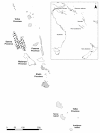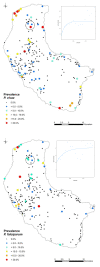Baseline spatial distribution of malaria prior to an elimination programme in Vanuatu
- PMID: 20525209
- PMCID: PMC2893196
- DOI: 10.1186/1475-2875-9-150
Baseline spatial distribution of malaria prior to an elimination programme in Vanuatu
Abstract
Background: The Ministry of Health in the Republic of Vanuatu has implemented a malaria elimination programme in Tafea Province, the most southern and eastern limit of malaria transmission in the South West Pacific. Tafea Province is comprised of five islands with malaria elimination achieved on one of these islands (Aneityum) in 1998. The current study aimed to establish the baseline distribution of malaria on the most malarious of the province's islands, Tanna Island, to guide the implementation of elimination activities.
Methods: A parasitological survey was conducted in Tafea Province in 2008. On Tanna Island there were 4,716 participants from 220 villages, geo-referenced using a global position system. Spatial autocorrelation in observed prevalence values was assessed using a semivariogram. Backwards step-wise regression analysis was conducted to determine the inclusion of environmental and climatic variables into a prediction model. The Bayesian geostatistical logistic regression model was used to predict malaria risk, and associated uncertainty across the island.
Results: Overall, prevalence on Tanna was 1.0% for Plasmodium falciparum (accounting for 32% of infections) and 2.2% for Plasmodium vivax (accounting for 68% of infections). Regression analysis showed significant association with elevation and distance to coastline for P. vivax and P. falciparum, but no significant association with NDVI or TIR. Colinearity was observed between elevation and distance to coastline with the later variable included in the final Bayesian geostatistical model for P. vivax and the former included in the final model for P. falciparum. Model validation statistics revealed that the final Bayesian geostatistical model had good predictive ability.
Conclusion: Malaria in Tanna Island, Vanuatu, has a focal and predominantly coastal distribution. As Vanuatu refines its elimination strategy, malaria risk maps represent an invaluable resource in the strategic planning of all levels of malaria interventions for the island.
Figures





References
-
- Feachem RA, Phillips A, Targett G. Shrinking the malaria map: A prospectus on malaria elimination. San Francisco: The Malaria Elimination Group; 2009.
-
- Sabot O, Tulloch J, Basu S, Dyckman W, Moonasar D, Moonenf B. In: Shrinking the malaria map: A prospectus on elimination. Feachem RGA, Phillips AA, Targett GA, editor. San Francisco: The Global Health Group; 2009. Getting to Zero.
Publication types
MeSH terms
LinkOut - more resources
Full Text Sources
Medical
Research Materials

